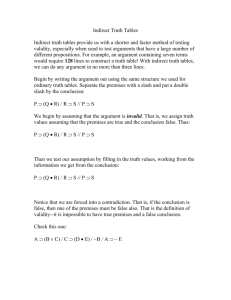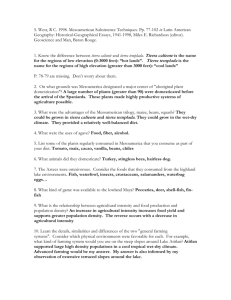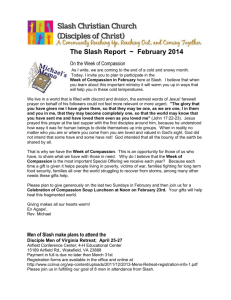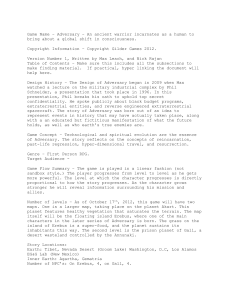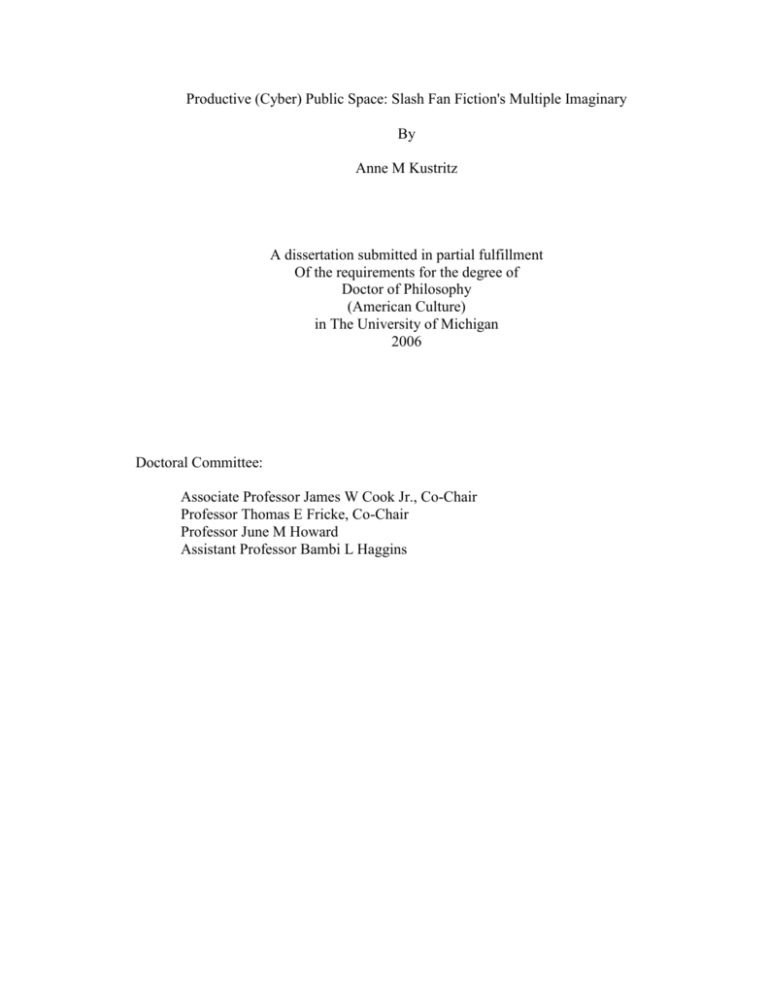
Productive (Cyber) Public Space: Slash Fan Fiction's Multiple Imaginary
By
Anne M Kustritz
A dissertation submitted in partial fulfillment
Of the requirements for the degree of
Doctor of Philosophy
(American Culture)
in The University of Michigan
2006
Doctoral Committee:
Associate Professor James W Cook Jr., Co-Chair
Professor Thomas E Fricke, Co-Chair
Professor June M Howard
Assistant Professor Bambi L Haggins
Anne Kustritz
Some Rights Reserved 2007
This work is licensed under the Creative Commons Attribution-Noncommercial-Share
Alike 3.0 United States License. To view a copy of this license, visit
http://creativecommons.org/licenses/by-nc-sa/3.0/us/ or send a letter to Creative
Commons, 543 Howard Street, 5th Floor, San Francisco, California, 94105, USA.
ii
Acknowledgements
First, I am deeply grateful to all of the slash readers, writers, and artists who
participated in this study and agreed to share their stories. Their voices greatly enriched
this project and it was my privilege to listen to their experiences. My thanks to the entire
slash community as well for building a space so full of creativity, warmth, complexity,
and vibrancy that it has afforded me endless opportunities for thinking and delight. I am
thankful every day that I’ve been able to live and work in a community that makes me
happy and gives me hope. Thanks are due as well to the friends I’ve made in and pulled
with me into slash. They have filled my world with revelry, camaraderie, and fabulous
excess.
I’m grateful to my committee members for believing in me and the project.
Thanks particularly to Jay Cook who provided extremely diligent and detailed input at
every stage. Thanks to Bambi Haggins whose passion for fan creativity consistently
reminded me that joy should be what the project is all about. Thanks to June Howard
who always challenged me to strive for my best and encouraged my growth as a thinker.
Thanks to Tom Fricke who convinced me that I’m an anthropologist at heart, if a highly
theorized one, and supported me and the project from my first term in graduate school.
Additionally, I owe a significant measure of my intellectual development to my
undergraduate Cultural Studies department at the University of Minnesota. My mentor
Robin Brown introduced me to Cultural Studies and encouraged me throughout the nine
year span of this research. I feel incredibly lucky to have his friendship, insight, and
iii
enthusiasm in my life. I’d also like to thank Thomas Pepper, Phil Regal, Liz Kotz,
Casare Casarino, and Gary Thomas from the Cultural Studies department whose classes
transformed my thinking, and Scott Crow from the Psychiatry department who provided
an excellent example of merging the qualitative and quantitative while I was his research
assistant, and who continued to encourage my scholarship after I decided to pursue
American Culture rather than Psychology at a graduate level.
I’ve been extremely fortunate to have received the consistent financial support of
several organizations, without which this journey would have been considerably more
arduous. These include the Andrew W. Mellon and Woodrow Wilson Foundations, The
University of Minnesota, The University of Michigan Regents, the Kopp Family
Foundation, and Rackham Graduate School.
Finally, I am awed by the contributions of my family and friends in nurturing my
nascent academic self, who nearly from birth wanted to become a Doctor some day, but
not the icky kind with blood. Thanks to my mother who has always believed in me, and
been my closest confidant, biggest fan, and foremost advocate. Thanks to my father who
always supports me and helps me achieve my dreams, even when he doesn’t understand
my reasons or agree with my conclusions. Thanks to my brother whose creativity amazes
me and who can always wrestle this stodgy academic into laughter. Thanks also to my
extended family, both biological and my extended family by choice through my
godmother Leslie, who helped shape me into the person I am today and who always
remind me that I make them proud. Clichés are born in attempts to describe the kind of
enduring love beyond the power of words that I’ve received from my parents, brother,
and family: God only knows what I’d be without you.
iv
Preface
Early on in the course of my nine year study, as I concluded my article “Slashing
the Romance Narrative,” I made a list of types of storytelling available in slash
communities which neither I, nor to my knowledge any other theorist of slash, had ever
addressed. Rediscovering the list years later, only to marvel at my earlier willingness to
overlook such narrative richness, these absences became a major motivating influence in
my decision to talk about slash in this project as a narrative space which sustains multiple
approaches to storytelling and living, rather than as a genre constrained to any one
aesthetic or ideological mode. A flexible term alternately used as a verb, adjective, or
noun, slash refers to texts produced and circulated almost exclusively by women, which
involve placing previously published characters of the same sex, usually male, into noncanonical romantic and/or erotic relationships with each other, as well as the
communities, identities, and spaces that participants build around that practice. By
sustaining public forums which normalize sexual multiplicity, female communities, and a
viewer’s freedom to usurp the “intended meaning” of a published representation slash
communities provide opportunities for encounters with a wide range of complex sexual,
relational, and political practices, thereby adding to readers’ tools for experiencing and
thinking about pleasure and ways of living.
Over the course of nearly a decade, I’ve studied and written about slash based
upon a combination of textual analysis, theoretical work, community observation, and online as well as embodied ethnographic interviews and participant-observation. While
v
anthropological methods contribute a vibrantly embodied level of detail and multiple
perspectives, I’ve attempted to situate my ethnographic data as suggestive, but
necessarily limited. The path of my own idiosyncratic travels through often hidden slash
communities has affected which practices I’ve been privy to as well as which stories I’ve
read, and the nearly infinite fragmentations within the community make truly
representative sampling practically impossible. However, this methodological problem
also offers an insight into the way that average participants abstract their notion of group
identity and textual meaning, i.e. their sense of what slash is, from limited, personal
experiences within only some slash spaces and some slash texts. “Slash” therefore offers
an illusory wholeness within which individuals collect completely unique textual and
relational experiences. These unpredictable experiences may facilitate some participants’
construction of hybrid social and sexual identities, while living in a largely female
community which normalizes a “benign” range of sexualities may enrich other
participants’ ability to think through the impact of heteronormativity and their own
heterosexual identity.
Thus because slash includes numerous sub-genres, and narrative styles, as a
textual practice the content of slash stories collectively advocate no single aesthetic or
ideology, but instead produce a multiple narrative space that broadens the field of
acceptable sexual and social possibility by upsetting systems of coercion which police
what can and cannot be said and known in public. I therefore advocate thinking about
slash as a queer, intersectional feminist space, characterized as such because hybrid
depictions of sexuality, including articulations of desire more complex than the biological
sex of object choice, level binary busting, inherently queer challenges to both patriarchy
vi
and heteronormativity. An intersectional focus redirects questions about the ethics of
sexual and community life from the moral content of sexual acts themselves, or the
“lifestyles” which legal frameworks insist that populations predicate upon them, to
consideration of systems of power and representation that constrain and shape people’s
ability to think about and evaluate their safe, intelligible, culturally approved choices for
constructing a way of life. As a genre, slash fan fiction uniformly equalizes only one
vector of power, biological sex and its attendant cultural meanings, but by manipulating
the effects of biological equivalence slash does not present a static utopian egalitarianism,
but stages in public space a range of multi-faceted sexual and relational questions and
possibilities.
Juxtaposing five (or six) distinct sexual aesthetics suggests the constantly
expanding proliferation of sexual fantasies and subject positions available under the
umbrella term “slash,” including many which incorporate types of violence, while also
gesturing toward the unique storytelling made possible by the use of two same-sexed
bodies which carry equivalent biological signifiers. Examining the symbolic significance
of interpenetration suggests large-scale ramifications in the meanings assigned to sexual
acts while suggesting the possibility of multiple similarly moral and desirable
egalitarianisms. Fans’ investment in objectively flawed characters and professional texts
gestures toward the possibility of accepting numerous “good lives.” Same-sexed
characters’ negotiation of consensual violence within the frame of chivalric “suffering for
love” prompts a reconsideration of sexual submission, while a state-mandated form of
consensual violence between same-sexed but opposite-gendered partners raises concerns
about the co-construction of gender, biological sex, and sexual domination in historical
vii
and contemporary debates about marriage. Non-consensual violence between samesexed partners offers a series of troubling but resonant questions regarding the kind of
egalitarianism built through mutual aggression, and intimate partners’ ability to cope with
otherness, forgiveness, and recognition in the wake of violence. Together, these textual
analyses build a holistic but never completed picture which requires the peaceful
coexistence of multiple, constantly proliferating modes of imagining pleasure,
storytelling, and living to fully understand slash fan fiction at the level of content.
Yet, rather than a scene of completely unrestricted proliferation, fan fiction also
interacts with legal, corporate, and fan enforced systems of restraint. In recent years
multi-national conglomerates and international law have scrambled to redefine copyright
and obscenity law in an era characterized by massive debates over the internet’s
facilitation of copying, and to subordinate all of cyberspace to market and nationalist
imperatives at the same time as thousands of artists, subcultures, and citizens of the
(cyber)world have turned to the democratic promise of virtual communities. The ability
to freely share fan fiction and other works of fan creativity in relative pseudononymous
safety has greatly facilitated fandom’s expansion on the internet, but fans establish their
virtual spaces a precarious step ahead of those who wish to impose one limited definition
of acceptable speech onto the entire internet, including copyright holders, service
providers, and at times even other fans. Slash fan fiction communities perform a vital
public function by providing a shared adult space where members and wandering
potential interlocutors may encounter and discuss a plethora of sexual and social
possibilities, and discuss the implications of various ways of living, dreaming, and being
viii
in relationship, but there is no guarantee that the creation of such spaces will remain
possible in the future.
Thus, I argue that by creating a public forum which puts numerous textual, virtual,
and embodied performances of sex, gender, and social life into dialogue, slash creates a
location for unpredictable collisions between people, ideas, and pleasures, thereby
establishing common space for the construction of new imaginaries. By encountering
slash some people form complex queer identities, some place primacy on textual
sexuality, others invest in largely female communities and friendships, some invest in
same-gendered erotics, while others reexamine their political and personal beliefs after
witnessing kinds of sexual and social life that dominant regimes of representation deem
unimaginable. None of these effects occur all of the time for everyone involved in slash,
but the opportunity to encounter and author new ways of experiencing pleasure,
relationships, and ways of living, whether through slash texts or community processes,
remains a valuable potential in and of itself. Exploring slash as a scholar, reader, author,
artist, or interested bystander affords unparalleled glimpses of a constantly expanding
horizon for representation and practice whose limits remain always just beyond our
current ability to fully imagine.
ix
Abstract
Productive (Cyber) Public Space: Slash Fan Fiction's Multiple Imaginary
By
Anne M Kustritz
Co-Chairs: James W Cook Jr. and Thomas E Fricke
My dissertation examines the social, identitarian, textual, and spatial significance of slash
fan fiction, a somewhat shifting designation for a type of writing largely produced and
circulated by women, which involves placing previously published characters of the same
sex, usually male, into non-canonical romantic and/or erotic relationships with each
other. Using an interdisciplinary blend of ethnographic observation, textual analysis, and
cultural studies theory, I argue that on-line slash communities create an alternate public
space which provides opportunities for encounters with a wide range of complex sexual,
relational, and political practices, thereby adding to readers’ tools for experiencing and
thinking about pleasure and ways of living. In thinking of slash as an identity, some slash
writers and readers use their involvement to construct a counter-cultural, queer selfconcept with real-life components while others enrich their ability to think through the
impact of heteronormativity by living in a largely female community which normalizes a
benign range of sexualities. As a textual practice the content of slash stories advocates no
single aesthetic or ideology but instead produces a multiple narrative space that broadens
x
the field of acceptable sexual possibility by upsetting systems of coercion which police
what can and cannot be said and known in public. Juxtaposing five (or six) distinct
sexual aesthetics suggests the constantly expanding proliferation of sexual fantasies and
subject positions available under the umbrella term “slash,” including many which
incorporate types of violence, while also gesturing toward the unique storytelling made
possible by the use of two same-sexed bodies which carry equivalent biological
signifiers. A study of slash as a public space first requires consideration of the ways that
copyright and obscenity law as well as the professional publishing industry shape and
constrain the kinds of storytelling and mythology available in public. Thus, I argue that
by creating a public forum which puts numerous textual, virtual, and embodied
performances of sex, gender, and social life into dialogue, slash creates a location for
unpredictable collisions between people, ideas, and pleasures, thereby establishing
common space for the construction of new imaginaries.
xi
Table of Contents
Acknowledgements
Preface
Abstract
iii
v
x
Chapter:
1. Mediated Travel and Cyberethnography in Slash Spaces:
Assembling Identity and Community Through Sexual Textual Exchange
2. Parallel Lives: Body Symbolism in a Multiple Narrative Space
3. Five Ways Mary Sue Never Had Sex
1
57
100
1. The Interpenetrative Aesthetic: Circularity and “Radical” Equality
2. The (Narrative) Wrinkles that Cradle Affection
3. Painful Pleasures, Sacrifice, and the Voyeuristic Reader
4. The Sexual Citizen and the State: Paradoxes of Masochistic Consent
5. Hobbesian Equivalence: Violence, Otherness, and Recognition
6. Non-Penetrative Sexuality, Queer Pleasures, and Benign
Sexual Variation
103
107
112
138
160
182
4. Discretionary Copyright Enforcement and its Discontents:
The Future of Free Speech and the Public Domain When What
“Turns [Some] on Grosses [Others] Out”
188
5. Things I Never Imagined: Unpredictable Encounters in Productive
Sex Publics
232
Filmography
Bibliography
253
256
xii



